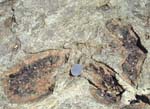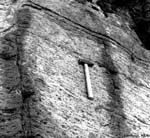

While much of our interpretation of metamorphic rocks revolves around the assumption of equilibrium among the various phases, there is abundant evidence of disequilibrium in rocks, including:
Evidence of disequilibrium/incomplete reaction can be seen at the outcrop, thin section, and grain scale. Amazing outcrops in Norway show partial transformation of granulites to eclogites:
This transition takes place along a clear reaction front whose progress is mediated by fluid flow:
At the grain scale, disequilibrium is often characterized by zoning:
Phase transformations (reactions) consist of two parts: nucleation and then growth. Kinetic experiments have revealed a great deal of information about nucleation mechanism, nucleation rate, growth mechanism, and growth rate. Neoblasts can be observed once they have grown to a sufficient size:
The growth of one phase into another depends on factors including the Gibbs free energy change of the reaction, interfacial free energy, strain free energy, and temperature. Growth mechanisms can be studied in considerable detail with transmission-electron microscopy:
And with optical microscopy:
View the motion of a reaction interface.
There's a special kind of phase transformation called a "martensitic transformation", in which the transformation occurs via twin propagation:
View the motion of a reaction interface.
As a specific example of kinetic experiments, let's consider the transformation of laumontite (a zeolite) to wairakite (another zeolite) + quartz + H2O:
Different textures develop at low and high temperatures:
The growth rate in each experiment is determined by measuring the sizes of neoblasts:
The apparent activation enthalpy of the growth rate can be determined from an Arrhenius plot:
The rate of the entire transformation is a result of nucleation and growth:
As a second example, let's consider the transformation of calcite
to aragonite.
Small amounts of transformation are characterized by growth of
aragonite along all calcite grain boundaries:
Measurements of the complete transformation rate as a function of pressure and temperature can be fit to an equation that includes nucleation and growth rate:
Under favorable circumstances, such data may be extrapolated to conditions in the Earth:
Textures are often a strong function of H2O content. The transformation of albite (left panel) to jadeite + quartz, for example, changes from discrete, rare nuclei in the presence of H2O (right panel), and many widespread nuclei in the absence of H2O (middle panel):
Here's the texture produced by the temperature-induced breakdown of biotite to spinel + orthopyroxene:
Characteristic of low H2O activities and thus slow grain-boundary diffusion are symplectites. This is a garnet-breakdown symplectite, often called kelyphite:
Symplectites result from decomposition reactions occurring under conditions where new crystals form and the diffusion rate is slower than the grain-boundary migration rate. Although product phases often have topotactic relationships with each other and/or the host phase, the shapes of the reaction products are often complex and controlled by the habit of the host phase:
In contrast, new minerals can also exsolve from host phases. In
this case, while topotactic relationships are also typical, the shapes
of the
reaction products are often simple and controlled by the crystallography of
the host phase.
Some lherzolites contain olivine with rods of FeTiO3:
Other orogenic lherzolites have olivines with exsolved plates of magnetite:
Plates of ilmenite exsolve high-pressure rutiles: